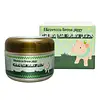What's inside
What's inside
 Key Ingredients
Key Ingredients

 Benefits
Benefits

 Concerns
Concerns

 Ingredients Side-by-side
Ingredients Side-by-side

Hydrolyzed Collagen
EmollientWater
Skin ConditioningDipropylene Glycol
HumectantPEG-240/Hdi Copolymer Bis-Decyltetradeceth-20 Ether
StabilisingGlycerin
HumectantGlyceryl Stearate
EmollientPEG-100 Stearate
Caprylic/Capric Triglyceride
MaskingMacadamia Ternifolia Seed Oil
EmollientDimethicone
EmollientMethylparaben
PreservativeSodium Hyaluronate
HumectantPhenoxyethanol
PreservativeAllantoin
Skin ConditioningTheobroma Cacao Extract
Skin ConditioningTocopheryl Acetate
AntioxidantPolyglutamic Acid
Skin ConditioningBacillus/Soybean Ferment Extract
Skin ConditioningPropylparaben
PreservativeAdenosine
Skin ConditioningDisodium EDTA
Parfum
MaskingHydrolyzed Collagen, Water, Dipropylene Glycol, PEG-240/Hdi Copolymer Bis-Decyltetradeceth-20 Ether, Glycerin, Glyceryl Stearate, PEG-100 Stearate, Caprylic/Capric Triglyceride, Macadamia Ternifolia Seed Oil, Dimethicone, Methylparaben, Sodium Hyaluronate, Phenoxyethanol, Allantoin, Theobroma Cacao Extract, Tocopheryl Acetate, Polyglutamic Acid, Bacillus/Soybean Ferment Extract, Propylparaben, Adenosine, Disodium EDTA, Parfum
Snail Secretion Filtrate 92%
Skin ConditioningCetearyl Olivate
Sorbitan Olivate
EmulsifyingCaprylic/Capric Triglyceride
MaskingButylene Glycol
HumectantCetearyl Alcohol
EmollientBetaine
HumectantDimethicone
EmollientCarbomer
Emulsion StabilisingEthyl Hexanediol
SolventPhenoxyethanol
PreservativeAllantoin
Skin ConditioningArginine
MaskingSodium Polyacrylate
AbsorbentSodium Hyaluronate
HumectantPanthenol
Skin ConditioningXanthan Gum
EmulsifyingAdenosine
Skin ConditioningPalmitic Acid
EmollientStearic Acid
CleansingWater
Skin ConditioningSodium Guaiazulene Sulfonate
Snail Secretion Filtrate 92%, Cetearyl Olivate, Sorbitan Olivate, Caprylic/Capric Triglyceride, Butylene Glycol, Cetearyl Alcohol, Betaine, Dimethicone, Carbomer, Ethyl Hexanediol, Phenoxyethanol, Allantoin, Arginine, Sodium Polyacrylate, Sodium Hyaluronate, Panthenol, Xanthan Gum, Adenosine, Palmitic Acid, Stearic Acid, Water, Sodium Guaiazulene Sulfonate
 Reviews
Reviews

Ingredients Explained
These ingredients are found in both products.
Ingredients higher up in an ingredient list are typically present in a larger amount.
Adenosine is in every living organism. It is one of four components in nucleic acids that helps store our DNA.
Adenosine has many benefits when used. These benefits include hydrating the skin, smoothing skin, and reducing wrinkles. Once applied, adenosine increases collagen production. It also helps with improving firmness and tissue repair.
Studies have found adenosine may also help with wound healing.
In skincare products, Adenosine is usually derived from yeast.
Learn more about AdenosineAllantoin is a soothing ingredient known for its protective and moisturizingg properties. Because of this, it is often added to products with strong active ingredients.
Studies show higher concentrations of this ingredient can promote wound healing.
Though it can be derived from the comfrey plant, allantoin is produced synthetically for cosmetic products to ensure purity.
Learn more about AllantoinThis ingredient is an emollient, solvent, and texture enhancer. It is considered a skin-softener by helping the skin prevent moisture loss.
It helps thicken a product's formula and makes it easier to spread by dissolving clumping compounds.
Caprylic Triglyceride is made by combining glycerin with coconut oil, forming a clear liquid.
While there is an assumption Caprylic Triglyceride can clog pores due to it being derived from coconut oil, there is no research supporting this.
Learn more about Caprylic/Capric TriglycerideDimethicone is a type of synthetic silicone created from natural materials such as quartz.
What it does:
Dimethicone comes in different viscosities:
Depending on the viscosity, dimethicone has different properties.
Ingredients lists don't always show which type is used, so we recommend reaching out to the brand if you have questions about the viscosity.
This ingredient is unlikely to cause irritation because it does not get absorbed into skin. However, people with silicone allergies should be careful about using this ingredient.
Note: Dimethicone may contribute to pilling. This is because it is not oil or water soluble, so pilling may occur when layered with products. When mixed with heavy oils in a formula, the outcome is also quite greasy.
Learn more about DimethiconePhenoxyethanol is a preservative that has germicide, antimicrobial, and aromatic properties. Studies show that phenoxyethanol can prevent microbial growth. By itself, it has a scent that is similar to that of a rose.
It's often used in formulations along with Caprylyl Glycol to preserve the shelf life of products.
Sodium Hyaluronate is hyaluronic acid's salt form. It is commonly derived from the sodium salt of hyaluronic acid.
Like hyaluronic acid, it is great at holding water and acts as a humectant. This makes it a great skin hydrating ingredient.
Sodium Hyaluronate is naturally occurring in our bodies and is mostly found in eye fluid and joints.
These are some other common types of Hyaluronic Acid:
Learn more about Sodium HyaluronateWater. It's the most common cosmetic ingredient of all. You'll usually see it at the top of ingredient lists, meaning that it makes up the largest part of the product.
So why is it so popular? Water most often acts as a solvent - this means that it helps dissolve other ingredients into the formulation.
You'll also recognize water as that liquid we all need to stay alive. If you see this, drink a glass of water. Stay hydrated!
Learn more about Water